Lower Cretaceous Carbonate Sequences in the Northwestern Persian Gulf Basin: A Response to the Combined Effects of Tectonic Activity and Global Sea-Level Changes
Abstract
:1. Introduction
2. Geological Overview
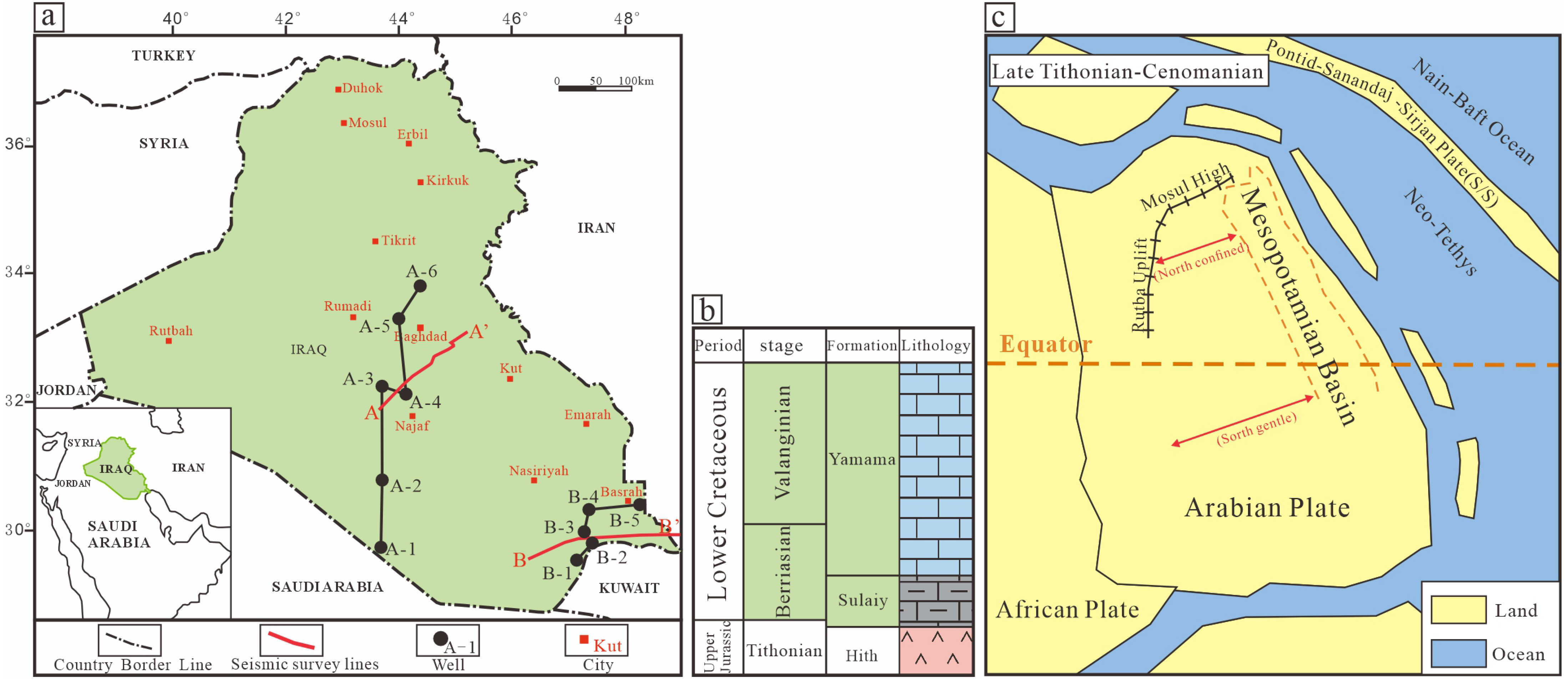
3. Materials and Methods
4. Results
4.1. Lithofacies Characteristics
4.1.1. Lithofacies Association 1: Various Types of Bioclastic Grainstone to Packstone
4.1.2. Lithofacies Association 2: Bioclast Mudstone to Wackestone
4.1.3. Lithofacies Association 3: Wackestone and Packstone
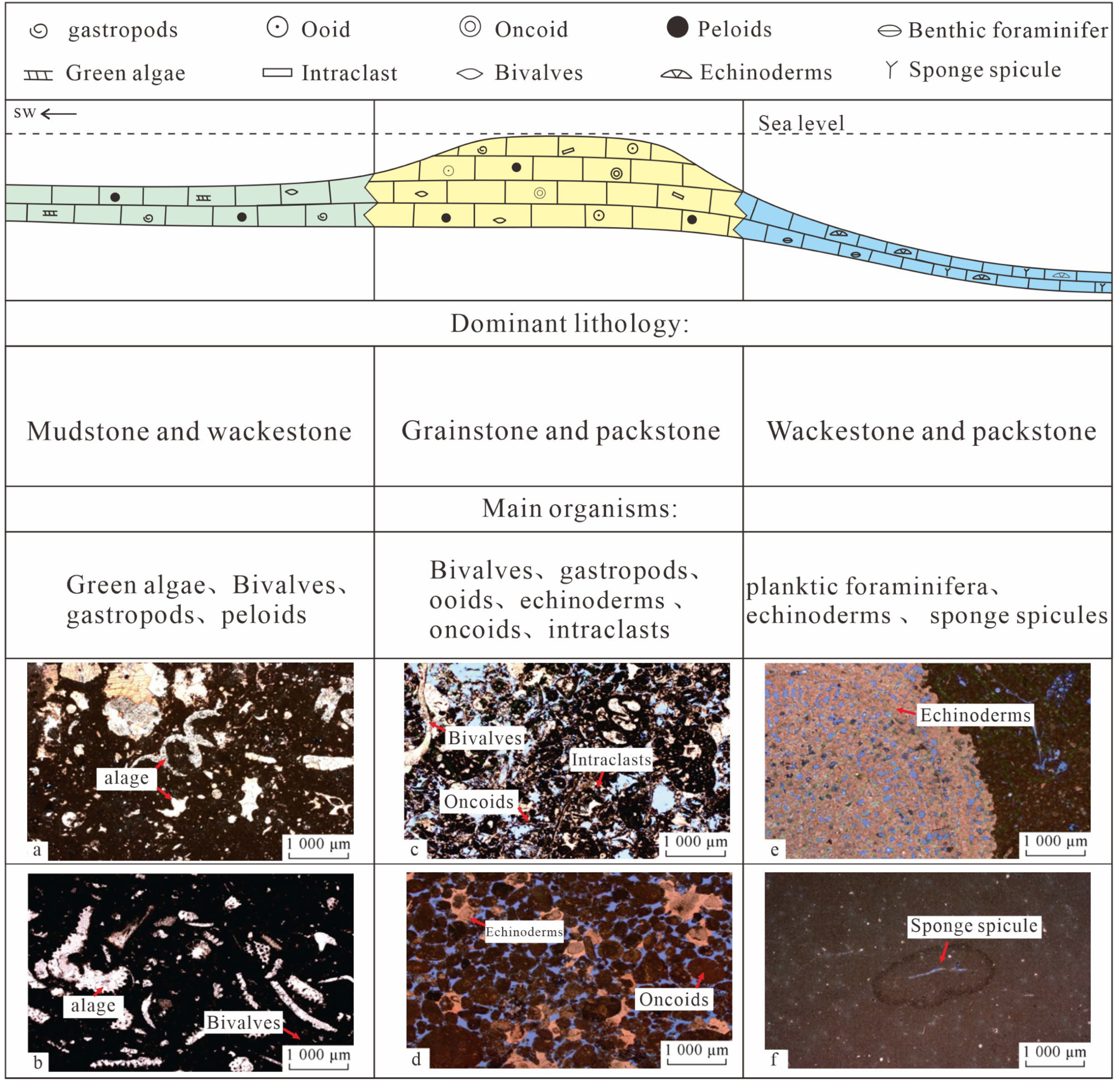
4.2. Sequence Identification and Facies Belt Division Based on Well-Seismic Integration
4.2.1. Well-Log Facies Characteristics
- (1)
- Finger-shaped (Figure 3a): This curve type exhibits the largest amplitude of variation, presenting a smooth finger-like or spike-shaped form. The SP curve is mostly medium to high in value, with occasional low-value segments, reflecting a depositional environment with relatively low energy in this section. Combined with lithology, which is mainly wackestone and packstone, it usually indicates a platform margin intertidal sedimentary response.
- (2)
- Funnel-shaped (Figure 3b): This type of SP curve shows a clear decreasing trend from bottom to top, indicating a gradual increase in hydrodynamic conditions over time. The lithology transitions from wackstone to grainstone, usually indicating a transition from slope or intertidal to platform-margin shoal facies.
- (3)
- Bell-shaped (Figure 3c): This type of curve is the opposite of the funnel-shaped one, with SP values gradually increasing from bottom to top, suggesting a weakening of hydrodynamic conditions from bottom to top. The lithology transitions from grainstone to packstone, typically indicating a transition from the platform margin to the inner platform.
- (4)
- Box-shaped (Figure 3d,e): The GR curve of this type shows a micro-toothed morphology (while the SP curve is relatively smooth). There is no significant change, and the values are relatively low, with abrupt contacts at both the top and bottom, representing stable and strong hydrodynamic conditions. The lithology is mainly grainstone, typically indicating high-energy microfacies, such as platform margin reefs and shoals. This curve morphology is a symbol of favorable reservoir development.
- (5)
- Linear (Figure 3f,g): This type of GR curve presents weakly toothed linear morphology (while the SP curve is relatively smooth). The curve is more gradual with higher values, reflecting stable and weak hydrodynamic conditions. The lithology is mainly Mudstone, typically in basin or deep shelf environments, which are usually favorable for hydrocarbon source rock development.
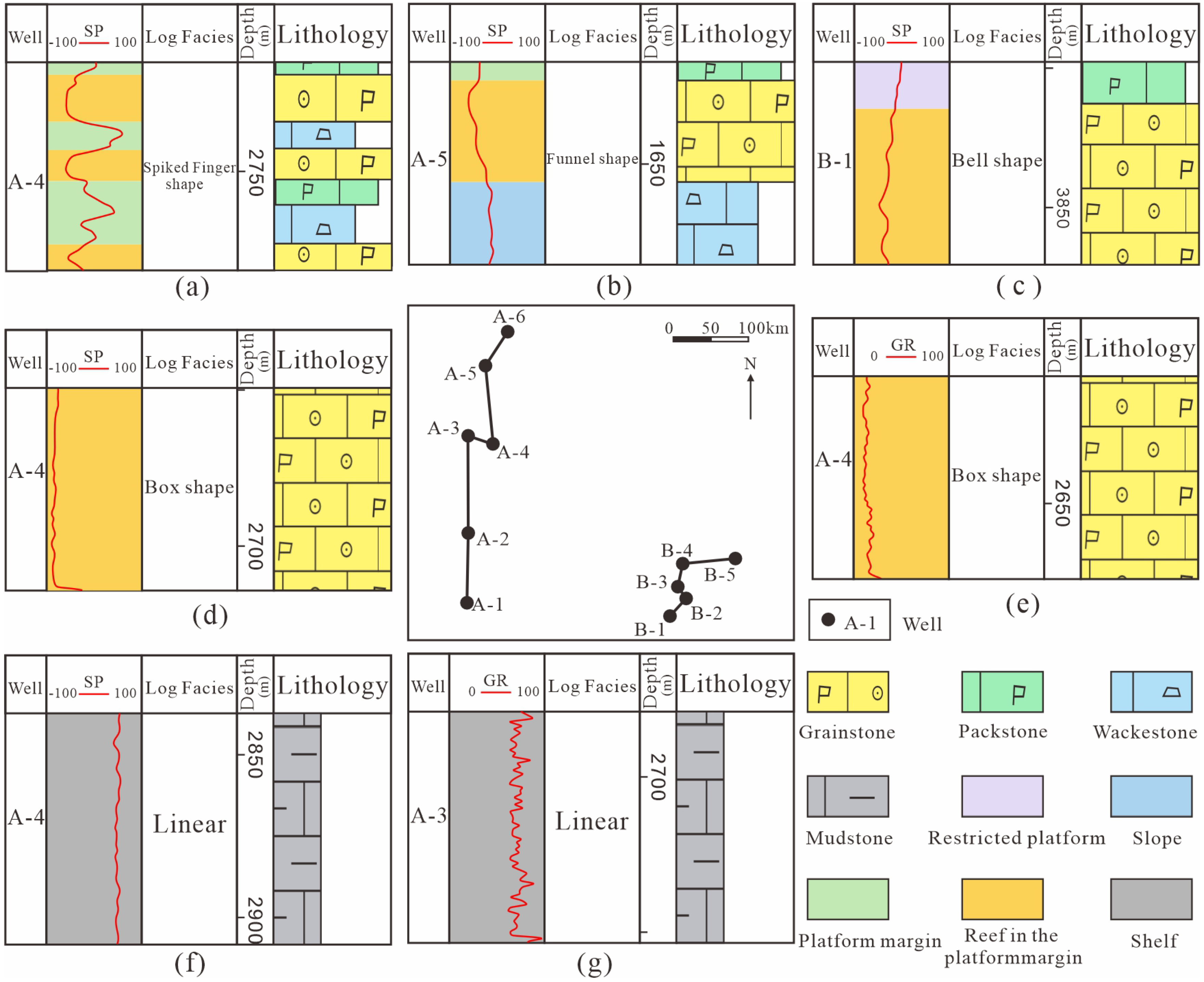
4.2.2. Seismic Sequence Identification
4.3. Distribution of Sedimentary Systems Within the Sequence Framework
5. Discussion
5.1. Depositional Model
5.2. Controls on Sequence Development
6. Conclusions
- (1)
- The Yamama Formation predominantly develops a carbonate platform facies, while the Sulaiy Formation predominantly develops a shelf facies. Seismic reflection termination relationships, such as downlap and truncation, were identified. Based on these relationships, five sequence boundaries (SB1, SB2, SB3, SB4, and SB5) were recognized on the seismic profiles. These boundaries correspond to one retrogradational sequence (SQ1) and three progradational sequences (SQ2, SQ3, and SQ4), with the SQ2–SQ4 strata displaying distinct progradational features.
- (2)
- Each sequence from SQ2 to SQ4 develops in a basin-slope-platform margin-restricted platform configuration, with large reefs developed in each sequence. Vertically, the facies prograde to the northeast. During the SQ2 period, the platform margin dip angle (<1°) indicates a ramp-type platform margin. In the SQ3 and SQ4 sequences, the platform margin dip angle is larger (1.2–1.5°), indicating a rimmed platform margin.
- (3)
- SQ1 is controlled by the Early Cretaceous global transgression, representing a sequence controlled by global sea-level changes. SQ2–SQ4 are controlled by the combined effects of tectonic activity and sea-level fluctuations, representing a tectonically influenced/global sea-level fluctuation sequence.
Author Contributions
Funding
Institutional Review Board Statement
Informed Consent Statement
Data Availability Statement
Conflicts of Interest
References
- Weilin, Z.; Guoping, B.; Jinsong, L. Oil and Gas Basins in the Middle East; Science Press: Beijing, China, 2014. [Google Scholar]
- Sharland, P.R.; Archer, R.; Casey, D.M.; Davies, R.B.; Simmons, M.D. Arabian Plate Sequence Stratigraphy. In GeoArabia; Gulf Petrolink: Tulsa, OK, USA, 2001. [Google Scholar]
- Naxin, T.; Jinyin, Y.; Chongzhi, T.; Fanjun, K. Petroleum geology and resources assessment of major basins in Middle East and Central Asia. Oil Gas Geol. 2017, 38, 10. [Google Scholar]
- Al-Iessa, I.A.; Zhang, W.Z. Facies evaluation and sedimentary environments of the Yamama Formation in the Ratawi oil field, South Iraq. Sci. Rep. 2023, 13, 5305. [Google Scholar] [CrossRef] [PubMed]
- Arkell, W.J.; Bramkamp, R.; Steineke, M. Jurassic ammonites from Jebel Tuwaiq, central Arabia with stratigraphical introduction. Philos. Trans. R. Soc. Lond. Ser. B Biol. Sci. 1952, 236, 241–314. [Google Scholar]
- Setudehnia, A. The mesozoic sequence in south-west Iran and adjacent areas. J. Pet. Geol. 2010, 1, 3–42. [Google Scholar]
- Motiei, H. Stratigraphy of Zagros. Treatise Geol. Iran 1993, 60, 237–245. [Google Scholar]
- Lasemi, Y.; Kondroud, K.N. Sequence stratigraphic control on prolific HC reservoir development, Southwest Iran. Oil Gas J. 2008, 106, 34–38. [Google Scholar]
- Bahrehvar, M.; Mehrabi, H.; Akbarzadeh, S.; Rahimpour-Bonab, H. Depositional and diagenetic controls on reservoir quality of the uppermost Jurassic–Lower Cretaceous sequences in the Persian Gulf; A focus on J–K boundary. J. Pet. Sci. Eng. 2021, 201, 108512. [Google Scholar] [CrossRef]
- Abd, O.K.; Abd, N. Seismic Sequence Stratigraphic Model and Hydrocarbon Potential of Yamama Formation in Al-Fao Area, Southeastern Iraq. Iraqi Geol. J. 2024, 57, 56–69. [Google Scholar]
- Khalil, R.; Jan, J.A. Facies analysis, depositional environment and diagenetic processes of the Lower Cretaceous Yamama Formation, Riyadh, Saudi Arabia. Carbonates Evaporites 2024, 39, 1–18. [Google Scholar]
- Mohsin, S.A.; Mohammed, A.H.; Alnajm, F.M. Facies Architecture and Depositional Marine Systems of the Yamama Formation in Selected Wells, Southern Iraq. Iraqi J. Sci. 2023, 64, 730–749. [Google Scholar]
- Rostamtabar, M.; Khanehbad, M.; Gharaie, M.H.M.; Mahboubi, A.; Hajian-Barzi, M. Facies analysis and sequence stratigraphy of the Lower Cretaceous strata (Fahliyan Formation) in Izeh Zone, Zagros Basin, SW Iran. Carbonates Evaporites 2022, 37, 1–19. [Google Scholar]
- Changqian, Z.; Qingchun, Z.; Haigang, D.; Fanqin, Z.; Xueling, W.; Xiaozhou, W. Characteristic and Favorable Area Prediction of Jurassic Plays in Iraq. Xinjiang Pet. Geol. 2013, 34, 116–120. [Google Scholar]
- Haiying, H.; Rui, G.; Jun, W.; Guosheng, Q.; Xiaowei, S.; Yichang, Y.; Haiyang, S.; Yang, G. Sequence stratigraphic framework and sedimentary evolution of the Cretaceous in southern Iraq. Earth Sci. Front. 2023, 30, 122–138. [Google Scholar]
- Guo-ping, B. A preliminary study of main control factors on oil and gas distribution in Persian Gulf Basin. J. China Univ. Pet. 2007, 31, 28–32, 38. [Google Scholar]
- HuCheng, D.; Wen, Z.; Rui, G.; MeiYan, F.; RunCheng, X.; WenLing, C.; XianFeng, P.; Rui, X. Pore structure characteristics and control factors of carbonate reservoirs: The Middle-Lower Cretaceous formation, AI Hardy cloth Oilfield, Iraq. Acta Petrol. Sin. 2014, 30, 801–812. [Google Scholar]
- Mehrabi, H.; Rahimpour-Bonab, H.; Al-Aasm, I.; Hajikazemi, E.; Esrafili-Dizaji, B.; Dalvand, M.; Omidvar, M. Palaeo-exposure surfaces in the Aptian Dariyan Formation, offshore SW Iran: Geochemistry and reservoir implications. J. Pet. Geol. 2018, 41, 467–494. [Google Scholar]
- Al-Fares, A.; Bouman, M.; Jeans, P. A New Look at the Middle to Lower Cretaceous Stratigraphy, Offshore Kuwait. GeoArabia 1998, 3, 543–560. [Google Scholar]
- Changqian, Z.; Qingchun, Z.; Peiguang, Y.; Haigang, D. Main controlling factors of hydrocarbon accumulation in Mesopotamia Basin. Pet. Geol. Exp. 2013, 35, 296–301. [Google Scholar]
- Yang, W.; Fengfeng, L.; Lixin, R.; Rui, G.; Ning, X.; Poppelreiter, M.; Gomes, J.C.; Lei, L. Carbonate rock characteristics and favorable reservoir origin in a slightly restricted depositional setting: A case study of Lower Cretaceous Yamama Formation in Oilfield A, Central Arabian Basin. Pet. Explor. Dev. 2024, 51, 1–15. [Google Scholar] [CrossRef]
- Huan, W.; Bo, L.; Kaibo, S.; Hangyu, L.; Bo, H. Characteristics of tectonic-sedimentary evolution from Jurassic to Cretaceous in Iraq-Iran area. Lithol. Reserv. 2021, 33, 15. [Google Scholar]
- Buday, T. The Regional Geology of Iraq; Publications of Geological Survey of Iraq: Baghdad, Iraq, 1980. [Google Scholar]
- Jassim, S.Z.; Goff, J.C. Geology of Iraq; Geological Society of London: London, UK, 2006. [Google Scholar]
- Al-Ameri, T.; Al-Musawi, F.; Batten, D. Palynofacies indications of depositional environments and source potential for hydrocarbons: Uppermost Jurassic-basal Cretaceous Sulaiy Formation, southern Iraq. Cretac. Res. 1999, 20, 359–363. [Google Scholar]
- Abdullah, F.; Connan, J. Geochemical study of some Cretaceous rocks from Kuwait: Comparison with oils from Cretaceous and Jurassic reservoirs. Org. Geochem. 2002, 33, 125–148. [Google Scholar]
- Mahdi, T.A. Stratigraphic Reservoir Characterization of Ratawi Formation in Southern Iraq. Iraqi Geol. J. 2024, 57, 65–77. [Google Scholar]
- Hakam, I.; Toomey, N.; Ghose, S.; Ponthier, J.; Zimmerman, J. Stratigraphic trap potential in the Lower Cretaceous Ratawi interval, Partitioned Zone PZ, Saudi Arabia and Kuwait. In Proceedings of the SPE Middle East Oil and Gas Show and Conference, Sanabis, Bahrain, 28 November–1 December 2021. [Google Scholar]
- Sadooni, F.N. Stratigraphic sequence, microfacies, and petroleum prospects of the Yamama Formation, Lower Cretaceous, southern Iraq. AAPG Bull. 1993, 77, 1971–1988. [Google Scholar]
- Beiwei, L.; Qingchun, Z.; Haigang, D.; Mingsheng, L.; Congsheng, B.; Ningning, Z.; Peiguang, Y.; Nai, W. Sedimentary response of Cretaceous tectonic evolution in the Middle East Rub Al Khali Basin and its inspirations for oil exploration. China Pet. Explor. 2020, 25, 115–124. [Google Scholar]
- Xiaobin, L.; Zhixin, W.; Zhaoming, W.; Zhengjun, H.; Chenpeng, S. Structural characteristics and main controlling factors on petroleum accumulation in Zagros Basin, Middle East. Nat. Gas Geosci. 2018, 29, 973–981. [Google Scholar]
- Bolin, Z. The Control of Arabian Plate Evolution on Oil and Gas Enrichment. Master’s Thesis, China University of Petroleum, Beijing, China, 2020. [Google Scholar]
- Aqrawi, A.A.M.; Goff, J.C.; Horbury, A.A.; Sadooni, F. The Petroleum Geology of Iraq; Scientific Press: Christchurch, New Zealand, 2010. [Google Scholar]
- Aliwi, H. Yamama Reservoir Characterization in the West Qurna Oil Field, Southern Iraq. Iraqi J. Sci. 2016, 57, 938–947. [Google Scholar]
- Mafraji, T.G.Z.A.; Al-Zaidy, A.A.H. Microfacies Architecture and Stratigraphic Development of the Yamama Formation, Southern Iraq. Iraqi J. Sci. 2019, 60, 1115–1128. [Google Scholar]
- Saleh, A.H. Microfacies and environmental study of the lower cretaceous yamama formation in Ratawi field. Arab. J. Geosci. 2014, 7, 3175–3190. [Google Scholar]
- Adabi, M.H.; Salehi, M.A.; Ghabeishavi, A. Depositional environment, sequence stratigraphy and geochemistry of Lower Cretaceous carbonates (Fahliyan Formation), south-west Iran. J. Asian Earth Sci. 2010, 39, 148–160. [Google Scholar]
- Tucker, M.E.; Wright, V.P. Carbonate Sedimentology; John Wiley & Sons: Hoboken, NJ, USA, 2009. [Google Scholar]
- Al-Ameri, T.K.; Al-Musawi, F.A.a. Hydrocarbon generation potential of the uppermost Jurassic—Basal Cretaceous Sulaiy formation, South Iraq. Arab. J. Geosci. 2011, 4, 53–58. [Google Scholar]
- Wolpert, P.; Bartenbach, M.; Suess, P.; Rausch, R.; Aigner, T.; Le Nindre, Y.M. Facies analysis and sequence stratigraphy of the uppermost Jurassic–Lower Cretaceous Sulaiy Formation in outcrops of central Saudi Arabia. GeoArabia 2015, 20, 67–122. [Google Scholar]
- Vail, P. Seismic stratigraphy and the evaluation of depositional sequences and facies. Geophys. J. R. Astron. Society 1983, 73, 278. [Google Scholar]
- Irwin, M. General theory of epeiric clear water sedimentation. AAPG Bull. 1965, 49, 445–459. [Google Scholar]
- Wilson, J.L. Carbonate Facies in Geologic History; Springer Science & Business Media: Berlin/Heidelberg, Germany, 2012. [Google Scholar]
- Liu, E.; Wang, H.; Pan, S.; Qin, C.; Jiang, P.; Chen, S.; Yan, D.; Lü, X.; Jing, Z. Architecture and depositional processes of sublacustrine fan systems in structurally active settings: An example from Weixinan Depression, northern South China Sea. Mar. Pet. Geol. 2021, 134, 105380. [Google Scholar]
- Liu, E.; Wang, H.; Feng, Y.; Pan, S.; Jing, Z.; Ma, Q.; Gan, H.; Zhao, J.-x. Sedimentary architecture and provenance analysis of a sublacustrine fan system in a half-graben rift depression of the South China Sea. Sediment. Geol. 2020, 409, 105781. [Google Scholar]
- Haq, B.U. Cretaceous eustasy revisited. Glob. Planet. Change 2014, 113, 44–58. [Google Scholar]
- Gale, A.S.; Mutterlose, J.; Batenburg, S.; Gradstein, F.M.; Agterberg, F.P.; Ogg, J.G.; Petrizzo, M.R. The Cretaceous Period. In Geologic Time Scale 2020; Elsevier: Amsterdam, The Netherlands, 2020; Volume 2, pp. 1023–1086. [Google Scholar]
- Zhichao, P.; Dongsheng, J.; Min, L.; Lei, S.; Jing, L.; Ziyang, G.; Lingyun, W.; Jun, W.; Yucai, D. Jurassic-Cretaceous oil-gas accumulation conditions and exploration potential in the thrust belt at the southern margin of Junggar Basin. Acta Pet. Sinica. Acta Pet. Sin. 2023, 44, 1258–1273. [Google Scholar]


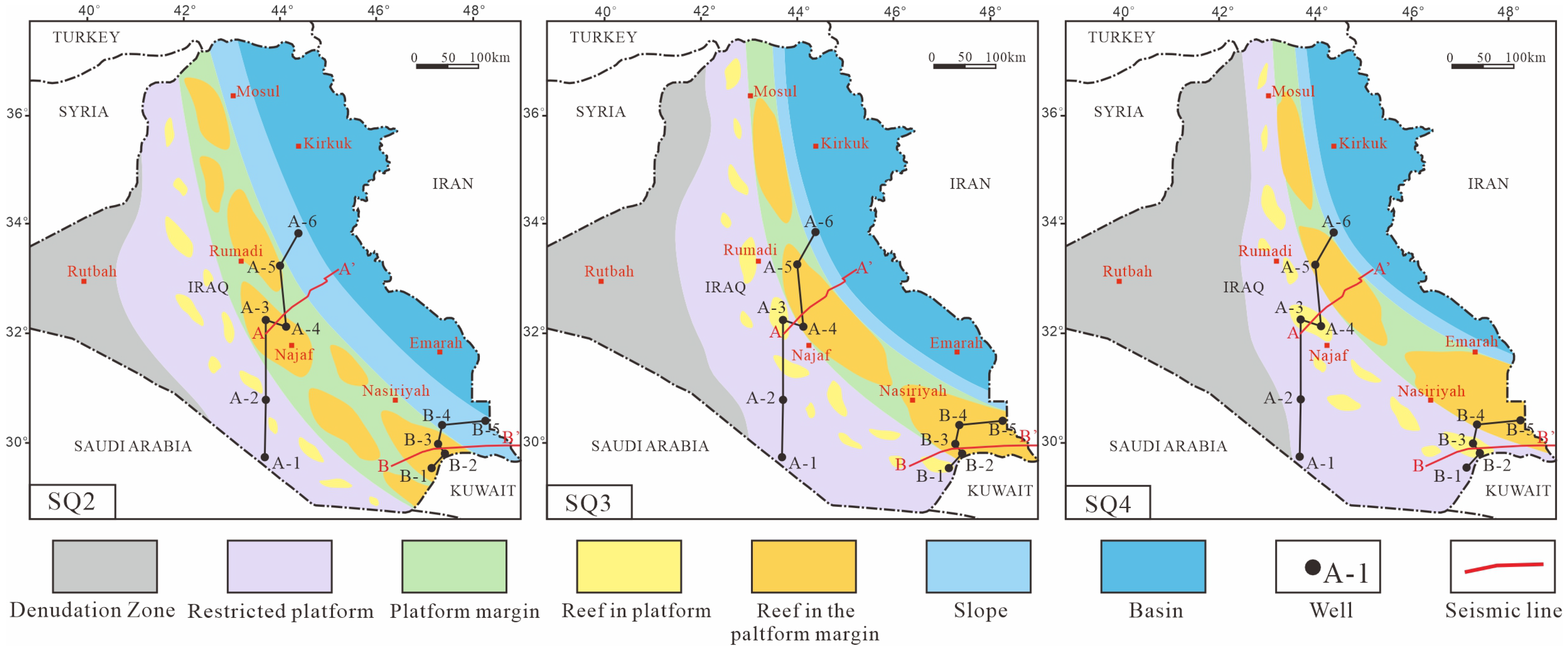


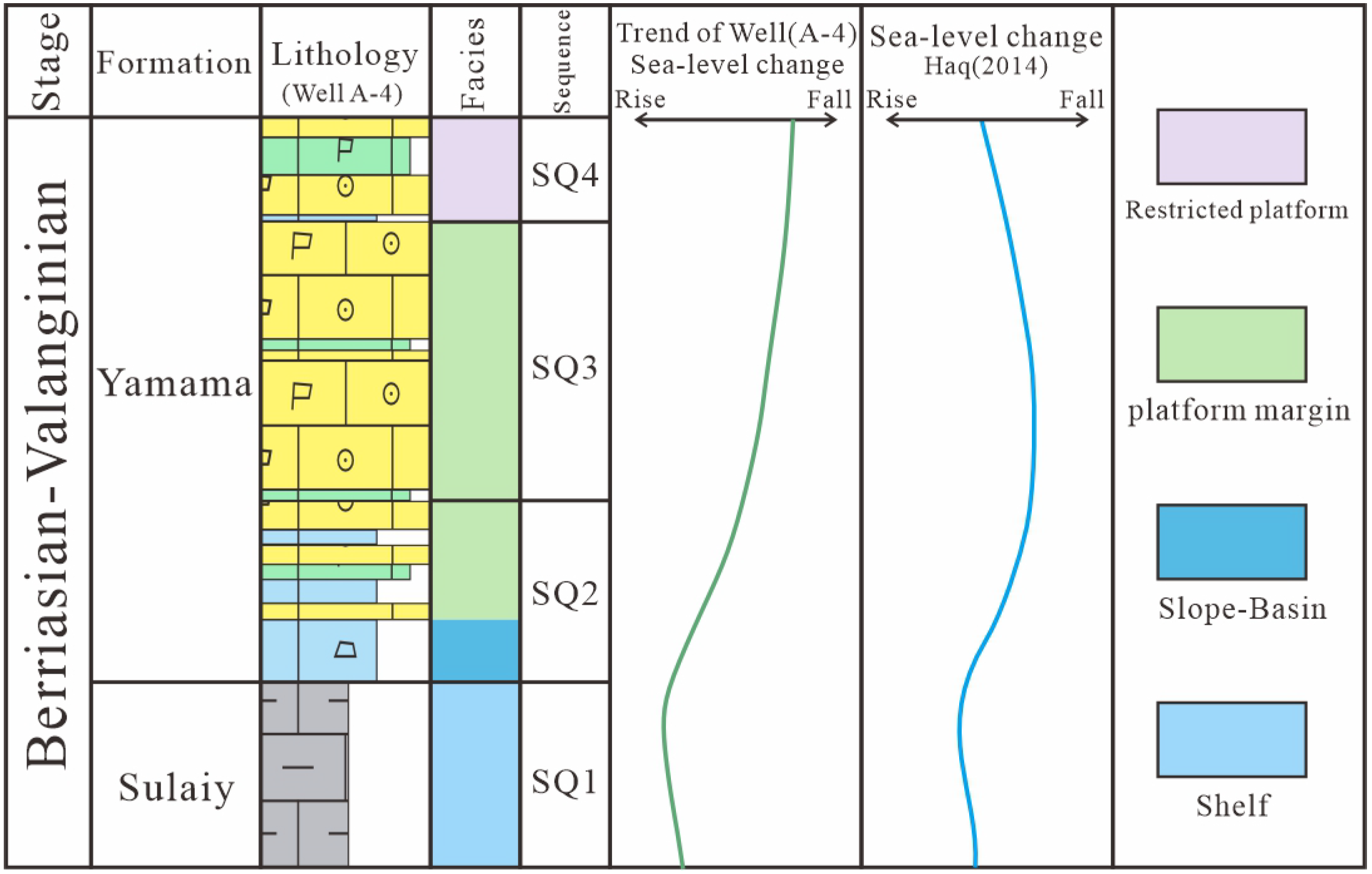
| Line | Section | L (m) | H (m) | Specific Value | Angle |
|---|---|---|---|---|---|
| A-A′ | Section-1 | 16,000 | 210 | 0.013125 | 0.75 |
| Section-2 | 11,200 | 240 | 0.021429 | 1.23 | |
| Section-3 | 10,500 | 260 | 0.024762 | 1.42 | |
| B-B′ | Section-1 | 14,000 | 170 | 0.012143 | 0.69 |
| Section-2 | 9500 | 200 | 0.021053 | 1.21 | |
| Section-3 | 9200 | 220 | 0.023913 | 1.37 |
Disclaimer/Publisher’s Note: The statements, opinions and data contained in all publications are solely those of the individual author(s) and contributor(s) and not of MDPI and/or the editor(s). MDPI and/or the editor(s) disclaim responsibility for any injury to people or property resulting from any ideas, methods, instructions or products referred to in the content. |
© 2025 by the authors. Licensee MDPI, Basel, Switzerland. This article is an open access article distributed under the terms and conditions of the Creative Commons Attribution (CC BY) license (https://creativecommons.org/licenses/by/4.0/).
Share and Cite
Wang, Y.; Cong, Q.; Chen, X.; Huang, W.; Han, R.; Gong, G. Lower Cretaceous Carbonate Sequences in the Northwestern Persian Gulf Basin: A Response to the Combined Effects of Tectonic Activity and Global Sea-Level Changes. Minerals 2025, 15, 363. https://doi.org/10.3390/min15040363
Wang Y, Cong Q, Chen X, Huang W, Han R, Gong G. Lower Cretaceous Carbonate Sequences in the Northwestern Persian Gulf Basin: A Response to the Combined Effects of Tectonic Activity and Global Sea-Level Changes. Minerals. 2025; 15(4):363. https://doi.org/10.3390/min15040363
Chicago/Turabian StyleWang, Yaning, Qinqin Cong, Xuan Chen, Wei Huang, Rui Han, and Gaoyang Gong. 2025. "Lower Cretaceous Carbonate Sequences in the Northwestern Persian Gulf Basin: A Response to the Combined Effects of Tectonic Activity and Global Sea-Level Changes" Minerals 15, no. 4: 363. https://doi.org/10.3390/min15040363
APA StyleWang, Y., Cong, Q., Chen, X., Huang, W., Han, R., & Gong, G. (2025). Lower Cretaceous Carbonate Sequences in the Northwestern Persian Gulf Basin: A Response to the Combined Effects of Tectonic Activity and Global Sea-Level Changes. Minerals, 15(4), 363. https://doi.org/10.3390/min15040363








